Vibration and Noise Analysis and Experimental Study of Rail Conveyor
Abstract
1. Introduction
2. Factors Affecting System Vibration and Noise
2.1. Influence of Wheel-Track System on Vibration and Noise
- The influence of track surface irregularity: Long-term operation of the rail conveyor may cause the track surface to wear, rough and uneven, or to have dark pits, which makes the track and the carriage wheels not smoothly contact, resulting in vibration between wheels and tracks;
- The effect of speed on vibration: Vibration is caused by the interaction between wheels and tracks when the support carriages pass through the tracks at a certain speed;
- Influence of rail weld joints: Long-running of the rail, due to the impact of the wheels, will lead to cracking of the weld at the rail joint, and the weld will appear low joint. The low joint phenomenon is common in the seamed structure, and the specific performance is that the joint at the weld seam sinks.
- Track surface irregularity model
- 2.
- Speed model
- 3.
- Track weld joint model
2.2. The Influence of Truss Structure on Track Noise
- Truss structure model
- 2.
- Track-truss coupling system model
- 3.
- Wheel-rail radiation noise prediction model
3. Methods and Procedures for Vibration and Noise Measurements
- Establish a test system and determine the test scheme
- 2.
- Instrument configuration process
- 3.
- Collect experimental data
4. Test Results and Analysis
4.1. Vibration Characteristics Analysis of Conveyor at Different Positions
- Locations above the vertical turnaround wheel and the track truss of the machine head
- In the part of the machine head, the vibration of the truss is obviously stronger than that of the vertical turnaround wheel under the same speed, and the vibration of the truss is mainly distributed in the frequency range of 1000–2000 Hz.
- The vertical vibration at the shaft of the side beam of the vertical turnaround wheel is greater than the axial vibration. At the track truss connections, the vibration amplitude under the speed of 2 m/s is about 4 times that at 1 m/s, and the vibration amplitude of the lower track truss connection is about twice that of the upper one.
- Unlike the vibration property on the track, the vertical and horizontal vibration intensity at the connection between the track and truss is at the same level.
- 2.
- Track connections
- For the three cases of the track joints, the vibration shock generated by the conveyor is distributed in the low-frequency band, mainly concentrated in the 0–1500 Hz area. The data output by the sensors will increase about three times when the conveyor speed is increased from 1 m/s to 2 m/s. The large fluctuations in the figure are the vibrations caused by the passing of the support carriage.
- Through the analysis of the vibration acceleration curve when the support carriage passes through, the vertical and axial vibration acceleration values of the track under the two operating speeds are all very large at the track weld step (Figure 14). This is because the track is in a completely disconnected state at the welded seam steps of the track, and the impact on both axial and vertical dynamic load is great when the carriage passes by.
- When the carriages passed through the places of the smooth and the relatively larger welding seams, the measured vibration acceleration curves showed similar trends. When the running speed was 1 m/s, the measured axial vibration acceleration of the track was about 10 times that of the vertical direction. As the operating speed increases, the vertical vibration acceleration decreases, which could be ignored when the operating speed is 2 m/s.
4.2. The Influence of Conveyor Track Parameters on Wheel-Track Noise
- The influence of conveyor running speed on the wheel and track noise
- 2.
- Influence of conveyor track fastener stiffness on wheel-rail noise
5. Improvement of System Vibration and Noise
- Reduce the surface roughness of wheels and tracks
- 2.
- Laying seamless rails
- 3.
- Rail damper
- 4.
- Set up sound barriers
6. Conclusions
- At the same speed, the vibration of the truss connection is more severe than that of the reversing wheel. This is mainly due to the impact generated during the process of the supporting vehicle changing from contact with the upper track to contact with the lower track after turning, and the impact strength increases with the speed. At the same running speed, the vertical and horizontal vibration amplitudes are basically the same.
- At different welds of the track, the width and depth of the rail gap have a great influence on the vibration impact, which is mainly due to the impact of the uneven impedance at the track gap, and the greater the running speed, the more obvious the vibration impact. This phenomenon is especially pronounced at larger welds. At the relatively flat weld, the vertical vibration can be ignored with the increase in speed.
- In the process of comparing the actual test signals, the prediction model can analyze the running noise of the conveyor very well. At different wheel-rail speeds, the noise prediction results show that as the speed increases, the conveyor noise increases in turn, and the trend of increase gradually tends to be gentle.
- The noise level increases with the increase in the fastener stiffness in general. However, when the frequency increases to a certain degree, e.g., greater than 1400 Hz, the fastener stiffness seems to have little effect on the noise level.
Author Contributions
Funding
Institutional Review Board Statement
Informed Consent Statement
Data Availability Statement
Conflicts of Interest
References
- Wheeler, C.A.; Carr, M.J.; Robinson, P.W.; Chen, B.; Lurie, M.; Ebert, S. Rail-Running Conveyors: A Disruptive New Belt-Conveying Technology. Min. Rep. 2022, 158, 479–493. [Google Scholar]
- Zhang, M.; Shi, H.; Zhang, Y.; Yu, Y.; Zhou, M. Deep learning-based damage detection of mining conveyor belt. Measurement 2021, 175, 109130. [Google Scholar] [CrossRef]
- Zhang, M.; Jiang, K.; Cao, Y.; Li, M.; Wang, Q.; Li, D.; Zhang, Y. A New Paradigm for Intelligent Status Detection of Belt Conveyors Based on Deep Learning. Measurement 2023, 213, 112735. [Google Scholar] [CrossRef]
- Bajda, M.; Hardygóra, M. Analysis of the Influence of the Type of Belt on the Energy Consumption of Transport Processes in a Belt Conveyor. Energies 2021, 14, 6180. [Google Scholar] [CrossRef]
- Wheeler, C.A. Development of the rail conveyor technology. Int. J. Min. Reclam. Environ. 2019, 33, 118–132. [Google Scholar] [CrossRef]
- Robinson, P.W.; Orozovic, O.; Meylan, M.H.; Wheeler, C.A.; Ausling, D. Optimization of the cross section of a novel rail running conveyor system. Eng. Optim. 2022, 54, 1544–1562. [Google Scholar] [CrossRef]
- Budiwantoro, B.; Agus Kariem, M.; Basia, R.R.; Prima, G. Stability Analysis of Rail-Conveyor for Coals Transportation. Appl. Mech. Mater. 2015, 758, 89–93. [Google Scholar] [CrossRef]
- Rahman, A.; Robinson, P.W.; Carr, M.J.; Wheeler, C.A. A dynamic analysis of the rail conveyor system. In Proceedings of the 13th International Conference on Bulk Materials Storage, Handling and Transportation (ICBMH 2019), Gold Coast, Australia, 9–11 July 2019; pp. 291–301. [Google Scholar]
- Carr, M.J.; Wheeler, C.A.; Robinson, P.W.; Chen, B. Reducing the energy intensity of overland conveying using a novel rail-running conveyor system. Int. J. Min. Reclam. Environ. 2021, 35, 183–198. [Google Scholar] [CrossRef]
- Hao, N.; Zhang, J.; Zhang, M.; Zhang, Y. Experimental research on vibration and noise of rail conveyor. Energy Rep. 2021, 7, 494–504. [Google Scholar] [CrossRef]
- Remington, P.J. Wheel/rail noise—Part I: Characterization of the wheel/rail dynamic system. J. Sound Vib. 1976, 46, 359–379. [Google Scholar] [CrossRef]
- Thompson, D.J. Wheel-rail noise generation, part III: Rail vibration. J. Sound Vib. 1993, 161, 421–446. [Google Scholar] [CrossRef]
- Jin, X. Research Progress of High-Speed Wheel–Rail Relationship. Lubricants 2022, 10, 248. [Google Scholar] [CrossRef]
- Yang, Z.; Li, Z. Numerical modeling of wheel-rail squeal-exciting contact. Int. J. Mech. Sci. 2019, 153, 490–499. [Google Scholar] [CrossRef]
- Sheng, X.; Cheng, G.; Thompson, D. Modelling wheel/rail rolling noise for a high-speed train running along an infinitely long periodic slab track. J. Acoust. Soc. Am. 2020, 148, 174–190. [Google Scholar] [CrossRef]
- Li, X.Z.; Liang, L.; Wang, D.X. Vibration and noise characteristics of an elevated box girder paved with different rail structures. J. Sound Vib. 2018, 425, 21–40. [Google Scholar] [CrossRef]
- Li, X.; Liu, Q.; Pei, S.; Song, L.; Zhang, X. Structure-borne noise of railway composite bridge: Numerical simulation and experimental validation. J. Sound Vib. 2015, 353, 378–394. [Google Scholar] [CrossRef]
- Mandula, J.; Salaiová, B.; Koval’akova, M. Prediction of noise from trams. Appl. Acoust. 2002, 63, 373–389. [Google Scholar] [CrossRef]
- Gu, Y.W.; Nie, X.; Yan, A.G.; Zeng, J.H.; Liu, Y.F.; Jiang, Y.X. Experimental and numerical study on vibration and structure-borne noise of high-speed railway composite bridge. Appl. Acoust. 2022, 192, 108757. [Google Scholar] [CrossRef]
- Liang, L.; Li, X.; Bi, R.; Gong, Z.; Sun, Y. Investigation of the effect of vibration-reducing tracks on the vibration and noise from a large-span steel bridge. J. Vib. Control 2023, 29, 2184–2197. [Google Scholar] [CrossRef]
- Liu, X.; Zhang, N.; Sun, Q.; Wang, Z.; Zang, C. An efficient frequency domain analysis method for bridge structure-borne noise prediction under train load and its application in noise reduction. Appl. Acoust. 2022, 192, 108647. [Google Scholar] [CrossRef]
- Hao, Q.; Shen, Y.; Wang, Y.; Liu, J. An adaptive extraction method for rail crack acoustic emission signal under strong wheel-rail rolling noise of high-speed railway. Mech. Syst. Sig. Process. 2021, 154, 107546. [Google Scholar] [CrossRef]
- He, Y.; Zhou, Q.; Xu, F.; Sheng, X.; He, Y.; Han, J. An investigation into the effect of rubber design parameters of a resilient wheel on wheel-rail noise. Appl. Acoust. 2023, 205, 109259. [Google Scholar] [CrossRef]
- Hou, B.; Li, J.; Gao, L.; Wang, D. Multi-Source Coupling Based Analysis of the Acoustic Radiation Characteristics of the Wheel–Rail Region of High-Speed Railways. Entropy 2021, 23, 1328. [Google Scholar] [CrossRef] [PubMed]
- Torstensson, P.T.; Squicciarini, G.; Krüger, M.; Pålsson, B.A.; Nielsen, J.C.; Thompson, D.J. Wheel–rail impact loads and noise generated at railway crossings–Influence of vehicle speed and crossing dip angle. J. Sound Vib. 2019, 456, 119–136. [Google Scholar] [CrossRef]
- Mazilu, T.; Dumitriu, M.; Răcănel, I.R. Parametric Study of the Influence of Nonlinear Elastic Characteristics of Rail Pads on Wheel–Rail Vibrations. Materials 2023, 16, 1531. [Google Scholar] [CrossRef] [PubMed]
- Song, X.; Wu, H.; Jin, H.; Cai, C.S. Noise contribution analysis of a U-shaped girder bridge with consideration of frequency dependent stiffness of rail fasteners. Appl. Acoust. 2023, 205, 109280. [Google Scholar] [CrossRef]
- Chiba, E.; Abdelkrim, M.; Belloufi, A.; Rezgui, I. Intelligent control of wheel rail contact noise phenomenon in rail transportation. IOP Conf. Ser. Mater. Sci. Eng. 2021, 1018, 012005. [Google Scholar] [CrossRef]
- Yang, Z.; Zhang, P.; Wang, L. Wheel-rail impact at an insulated rail joint in an embedded rail system. Eng. Struct. 2021, 246, 113026. [Google Scholar] [CrossRef]
- Thompson, D.J.; Jones, C.J.C.; Waters, T.P.; Farrington, D. A tuned damping device for reducing noise from railway rail. Appl. Acoust. 2007, 68, 43–57. [Google Scholar] [CrossRef]


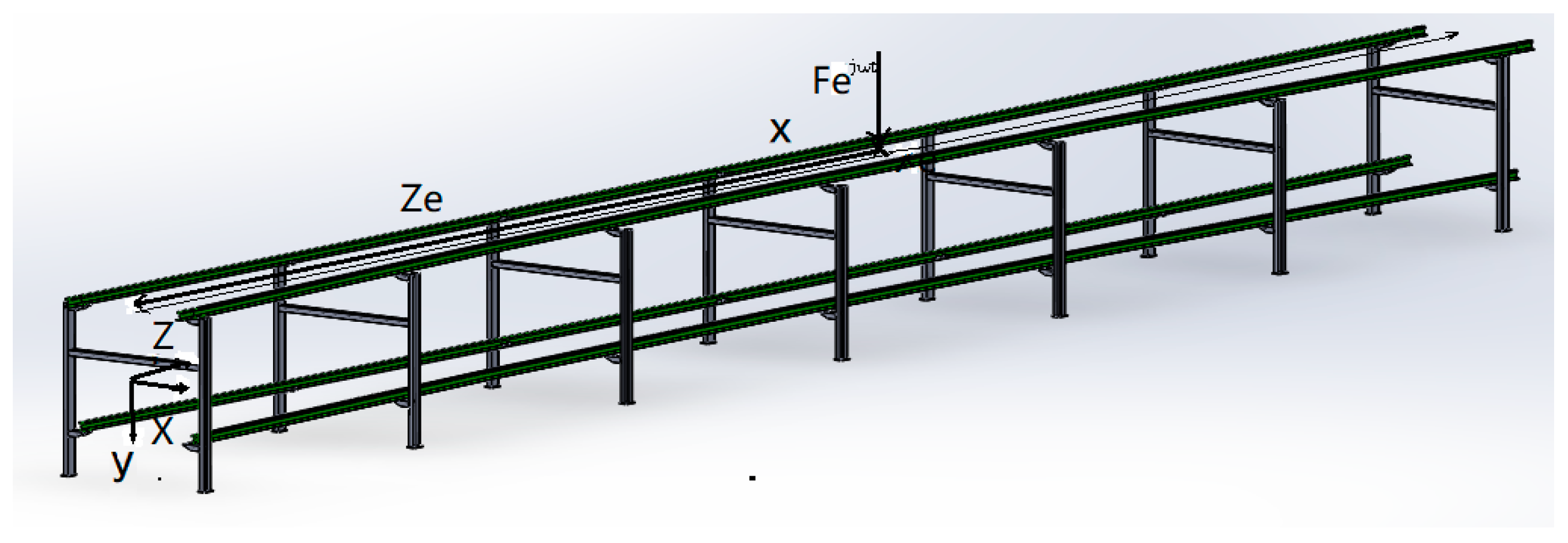


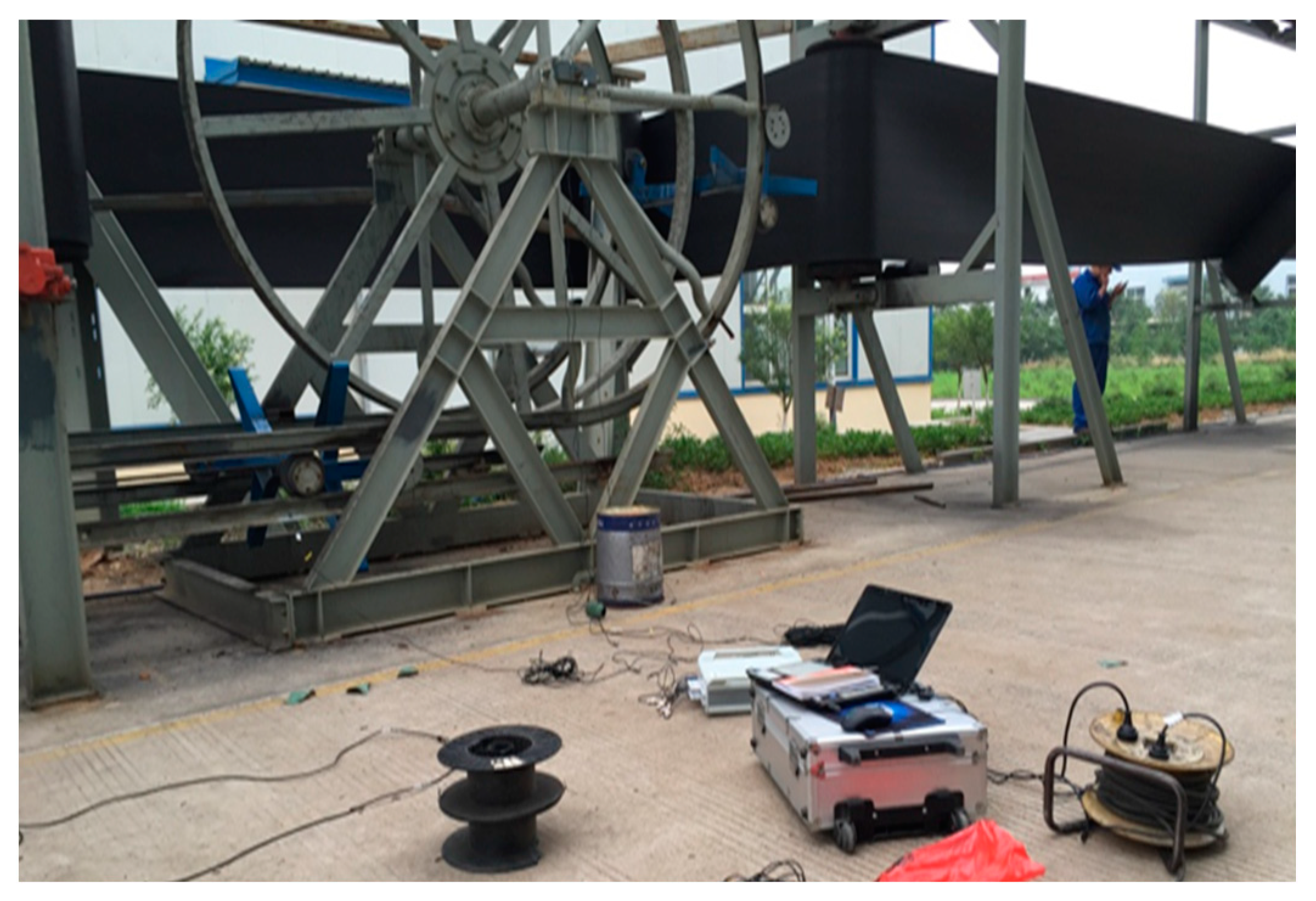


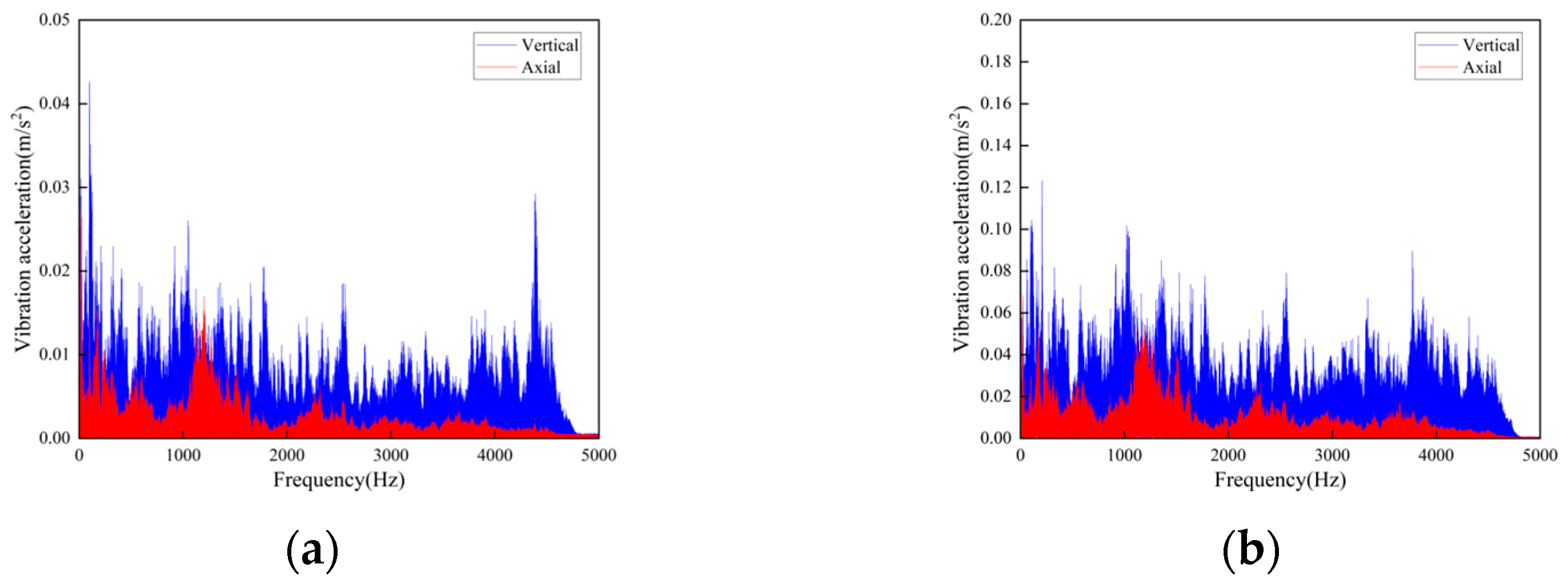
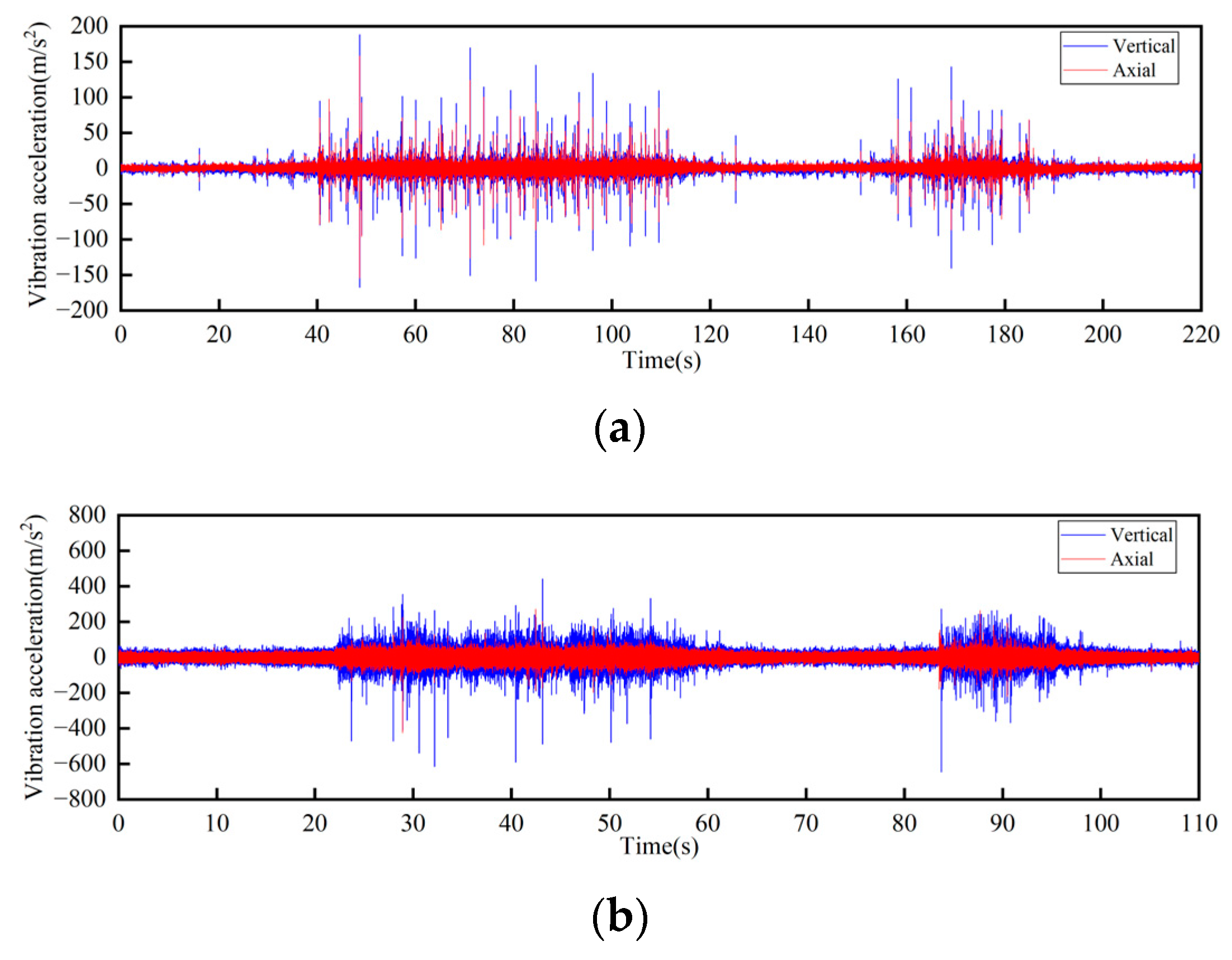
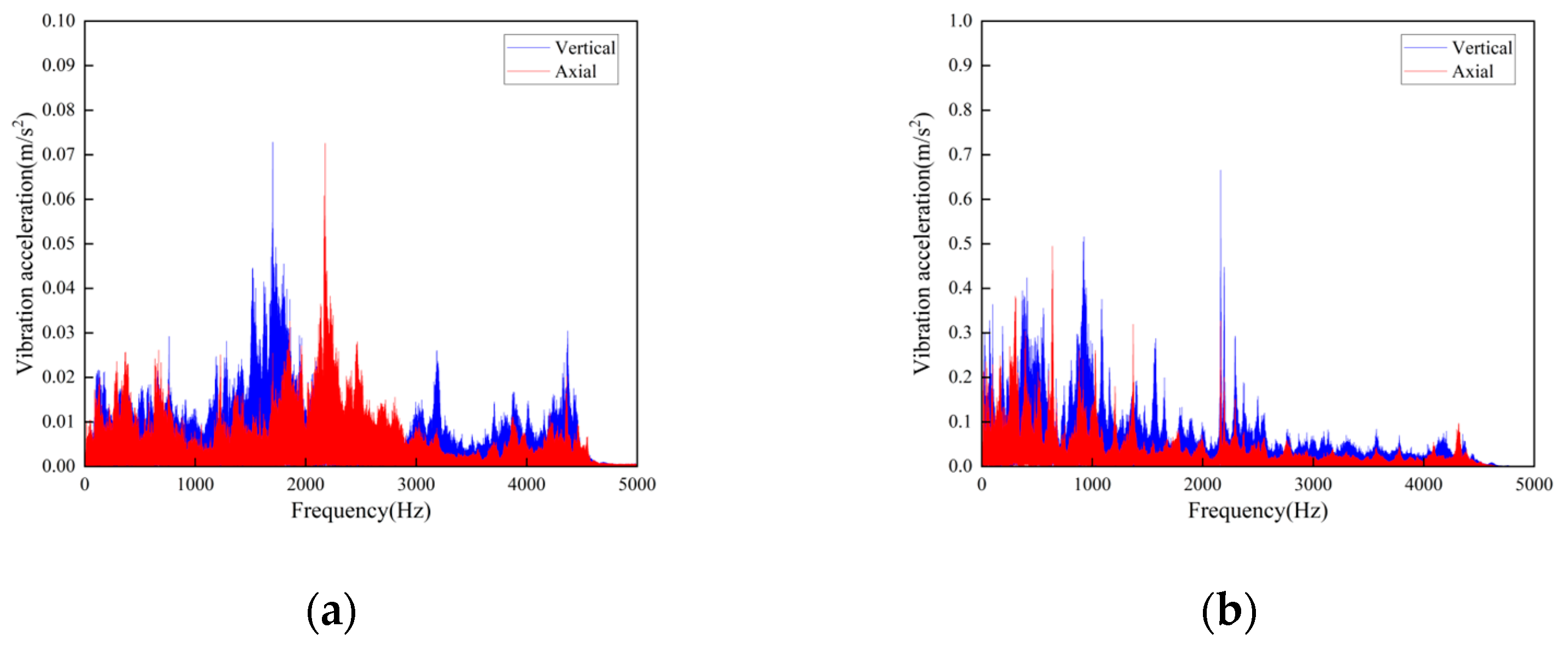

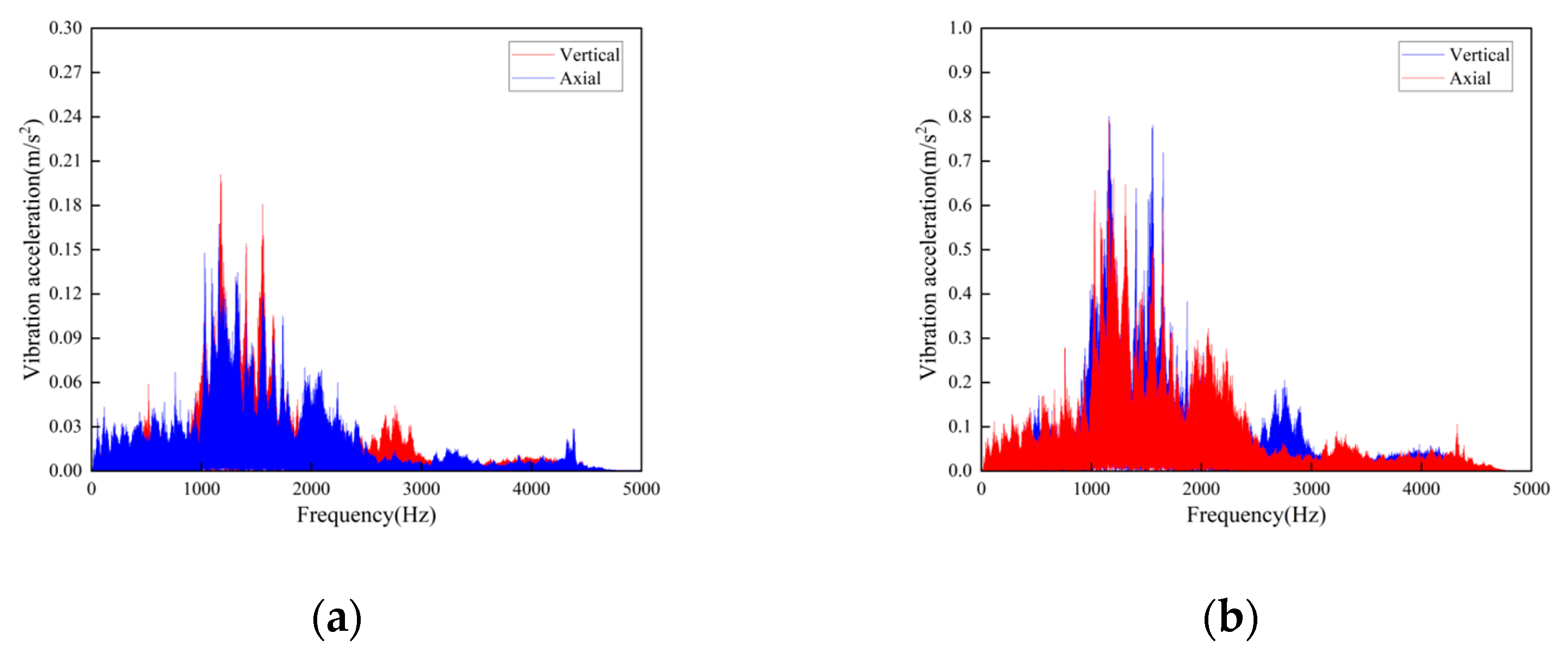
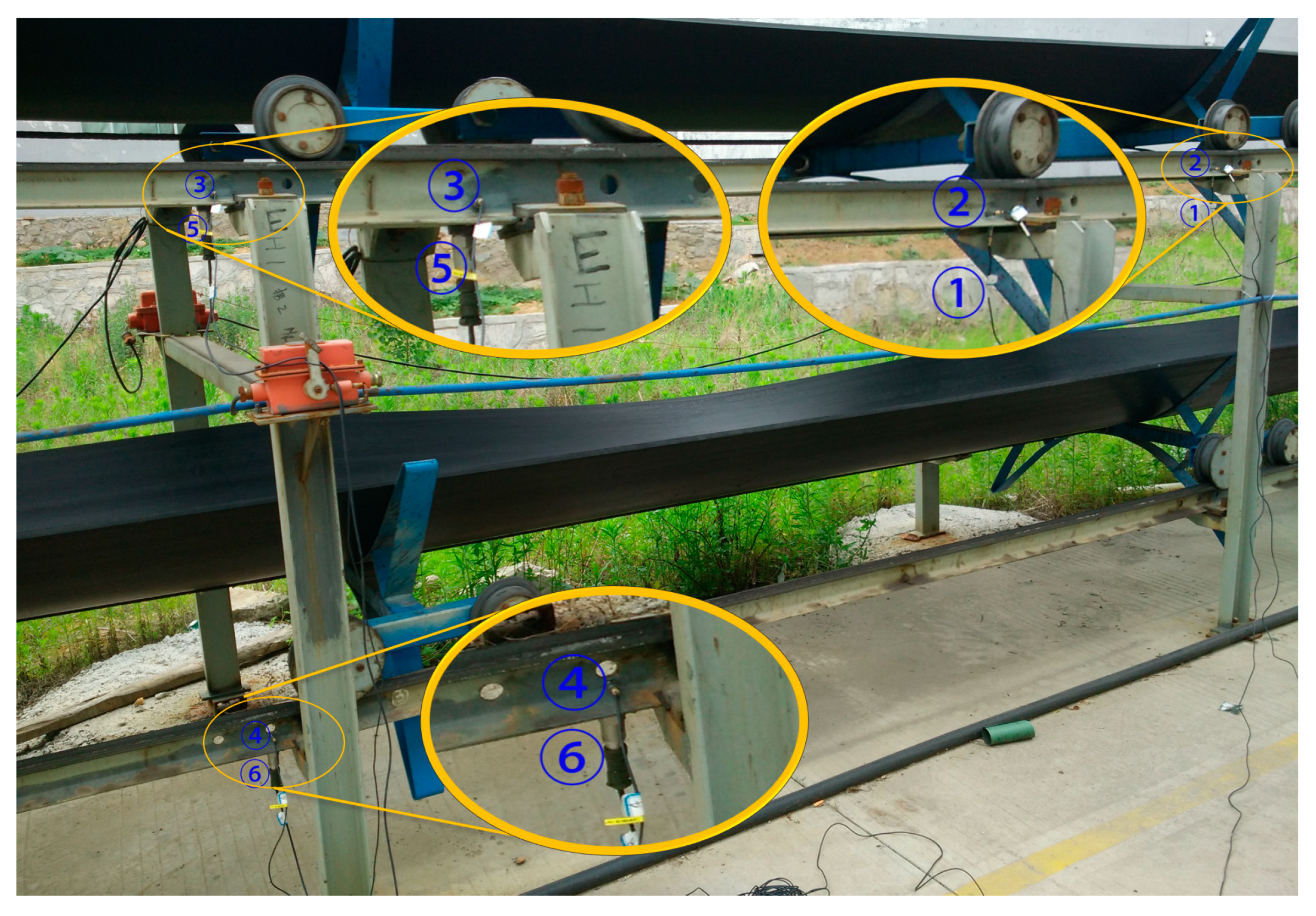


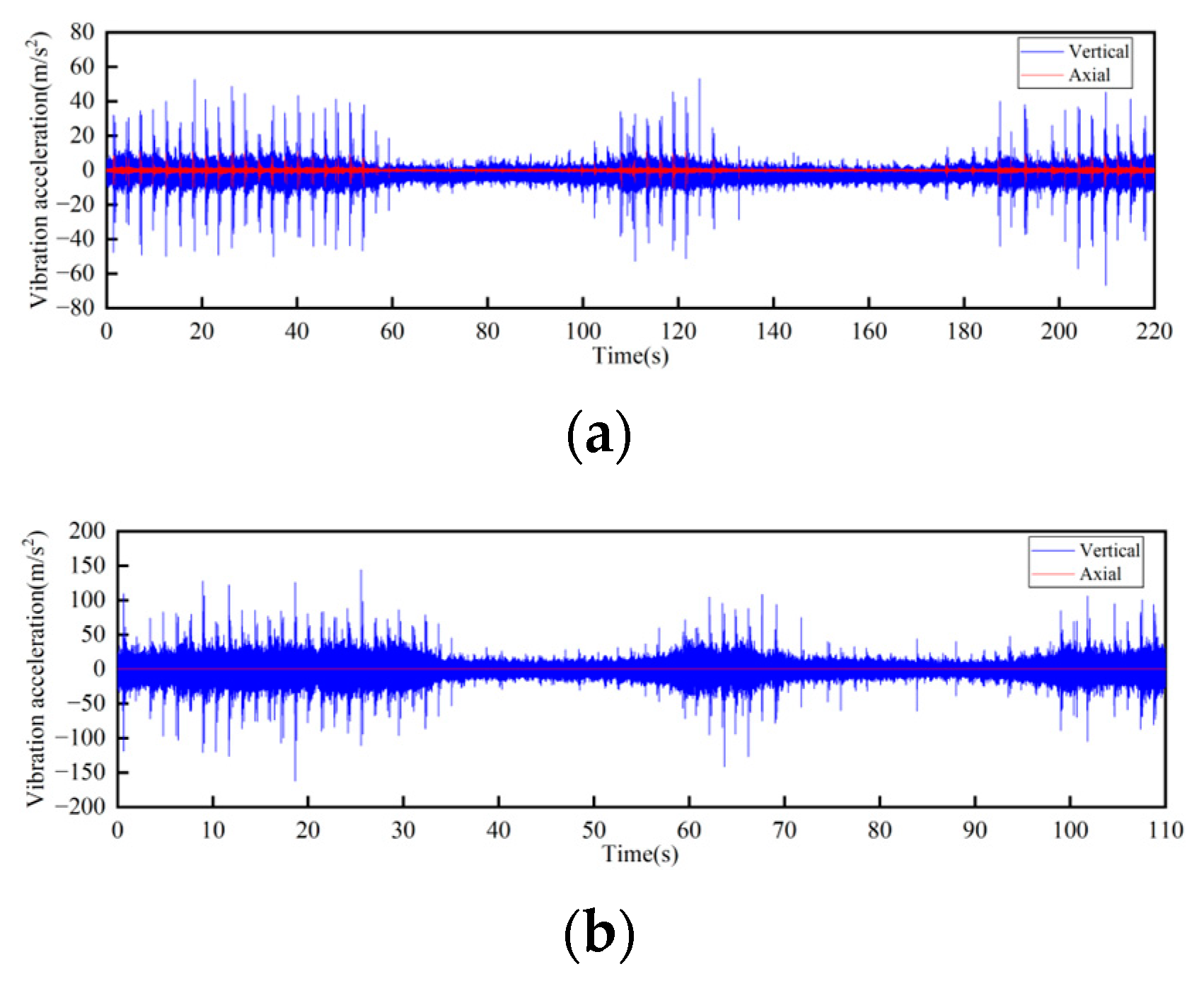
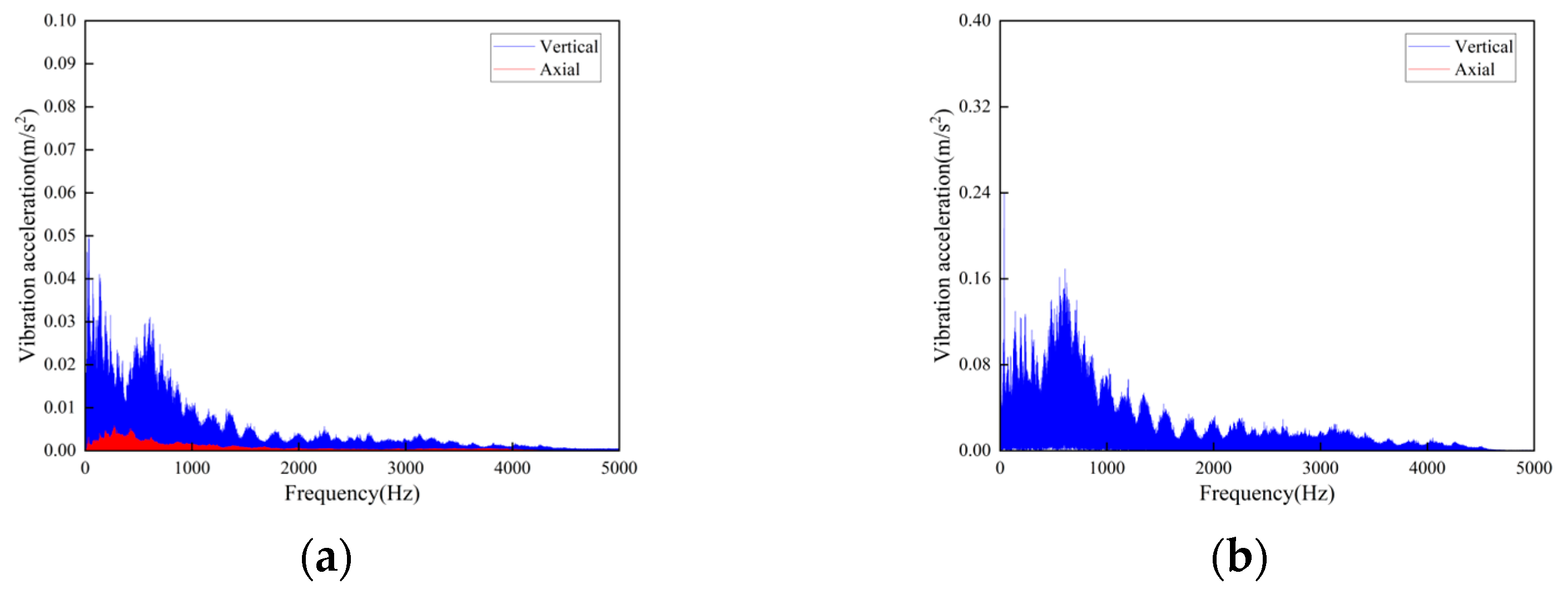


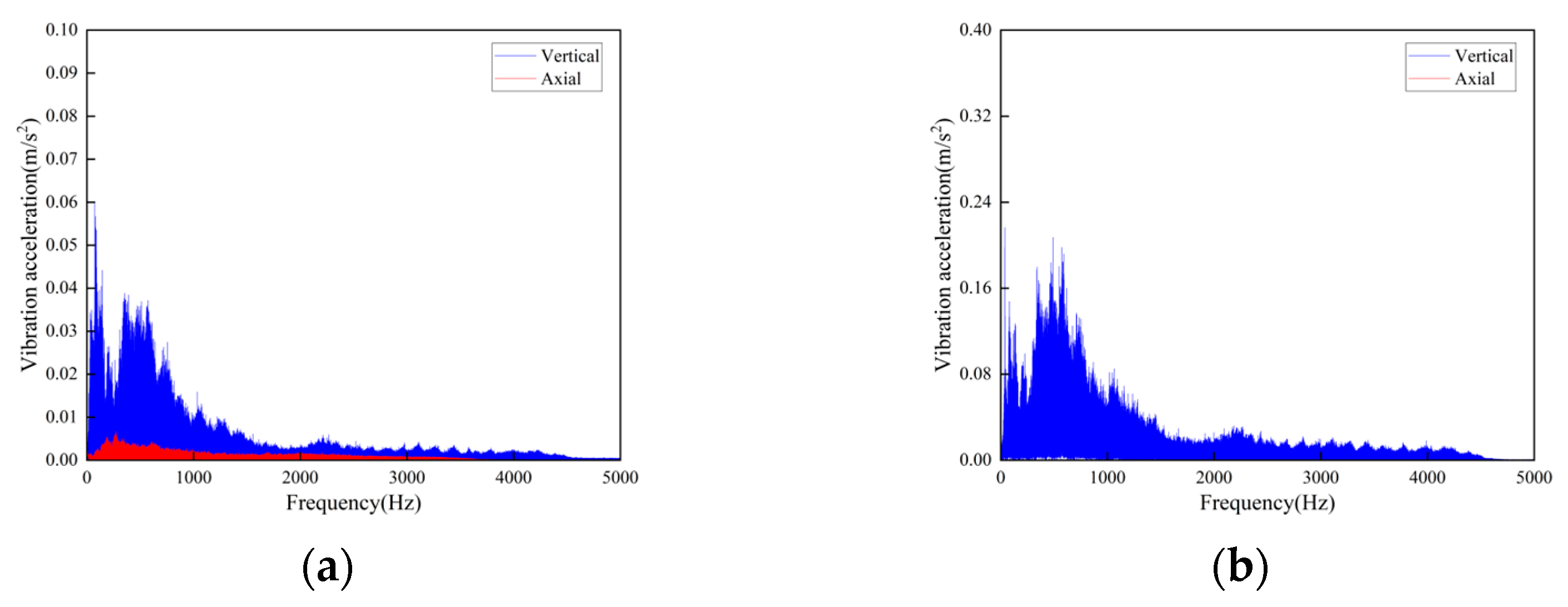





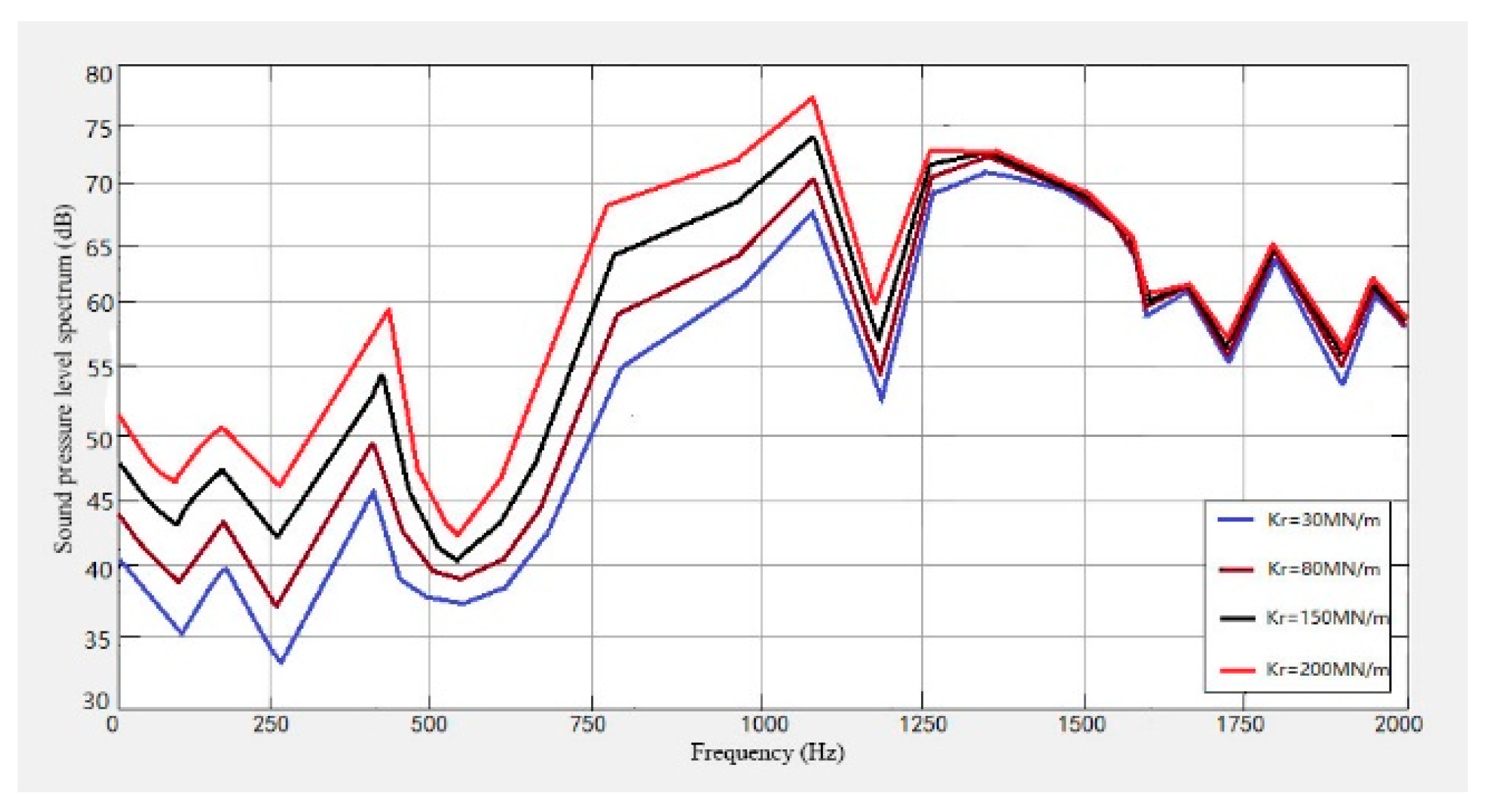



| Serial Number | Name | Serial Number | Installation Location | Testing Direction | Running Speed | Sampling Frequency |
| 1 | DH131E | ① | Side of vertical turnaround wheel | Vertical | 1 m/s, 2 m/s | 10 kHz |
| 2 | DH131E | ② | Side of vertical turnaround wheel | Axial | 1 m/s, 2 m/s | 10 kHz |
| 3 | DH131E | ③ | Side of vertical turnaround wheel | Horizontal | 1 m/s, 2 m/s | 10 kHz |
| 4 | DH131E | ④ | Upper track truss connection | Vertical | 1 m/s, 2 m/s | 10 kHz |
| 5 | DH131E | ⑤ | Upper track truss connection | Axial | 1 m/s, 2 m/s | 10 kHz |
| 6 | DH311E | ⑥ | Lower track truss connection | Axial | 1 m/s, 2 m/s | 10 kHz |
| 7 | DH311E | ⑦ | Lower track truss connection | Vertical | 1 m/s, 2 m/s | 10 kHz |
| Serial Number | Name | Serial Number | Installation Location | Testing Direction | Running Speed | Sampling Frequency |
| 1 | DH131E | ① | Weld step | Vertical | 1 m/s, 2 m/s | 10 kHz |
| 2 | DH131E | ② | Weld step | Axial | 1 m/s, 2 m/s | 10 kHz |
| 3 | DH131E | ③ | Relatively flat | Axial | 1 m/s, 2 m/s | 10 kHz |
| 4 | DH131E | ④ | Larger weld | Axial | 1 m/s, 2 m/s | 10 kHz |
| 5 | AC133-1D | ⑤ | Relatively flat | Vertical | 1 m/s, 2 m/s | 10 kHz |
| 6 | AC133-1D | ⑥ | Larger weld | Vertical | 1 m/s, 2 m/s | 10 kHz |
Disclaimer/Publisher’s Note: The statements, opinions and data contained in all publications are solely those of the individual author(s) and contributor(s) and not of MDPI and/or the editor(s). MDPI and/or the editor(s) disclaim responsibility for any injury to people or property resulting from any ideas, methods, instructions or products referred to in the content. |
© 2023 by the authors. Licensee MDPI, Basel, Switzerland. This article is an open access article distributed under the terms and conditions of the Creative Commons Attribution (CC BY) license (https://creativecommons.org/licenses/by/4.0/).
Share and Cite
Hao, N.; Sun, X.; Zhang, M.; Zhang, Y.; Wang, X.; Yi, X. Vibration and Noise Analysis and Experimental Study of Rail Conveyor. Sensors 2023, 23, 4867. https://doi.org/10.3390/s23104867
Hao N, Sun X, Zhang M, Zhang Y, Wang X, Yi X. Vibration and Noise Analysis and Experimental Study of Rail Conveyor. Sensors. 2023; 23(10):4867. https://doi.org/10.3390/s23104867
Chicago/Turabian StyleHao, Nini, Xinming Sun, Mengchao Zhang, Yuan Zhang, Xingyu Wang, and Xiaoting Yi. 2023. "Vibration and Noise Analysis and Experimental Study of Rail Conveyor" Sensors 23, no. 10: 4867. https://doi.org/10.3390/s23104867
APA StyleHao, N., Sun, X., Zhang, M., Zhang, Y., Wang, X., & Yi, X. (2023). Vibration and Noise Analysis and Experimental Study of Rail Conveyor. Sensors, 23(10), 4867. https://doi.org/10.3390/s23104867





